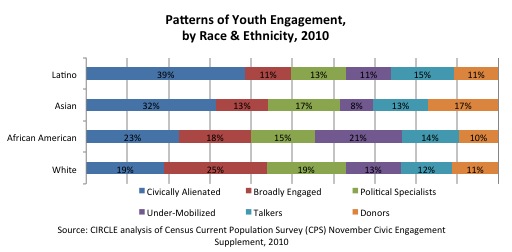New Analysis: Political Engagement of Asian American, African American, and Latino Youth
Political campaigns and commentators often think of the “youth” as a monolithic voting bloc. But young people in America are an increasingly diverse group with varied political and ideological views, and different ways of engaging in political and civic life.
Today, we release three new fact sheets with recent data and analysis about the electoral engagement of African American youth, Asian American youth, and Latino youth. The fact sheets explore their voter registration and turnout rates, as well as broader patterns of engagement among young people from different racial and ethnic backgrounds.
Some key findings:
- In the past three election cycles (2008, 2010, 2012) young African Americans turned out to vote at a higher rate than youth of any other racial or ethnic group.
- Latino youth vote and are registered to vote at significantly lower levels than their White and African American peers. They are the most “civically alienated” racial or ethnic group of youth (see clusters in graph below).
Asian American youth are less likely than young people in other racial and ethnic groups to engage in formal electoral politics—they were the least likely to be registered to vote in 2012—but are active through political discussion and through donating to charitable causes.
Based on these analyses, we make several recommendations for how to better engage youth of different backgrounds. For example:
- Latinos are the most likely to fit into the “talkers” cluster among of youth of different ethnic backgrounds. Engaging youth in conversations about important public issues may serve as an entry point that connects them to civic organizations and activities.
- Use more than one strategy to reach a large number of youth. For example, strategies focused solely on college campuses may miss a large proportion of this demographic group, as 40% of youth do not have college experience, and young African Americans and Latinos are more likely to have no college experience than youth as a whole nationally.
- Asian American youth can be engaged through school activities, as they are the most likely, compared to other racial and ethnic youth groups, to engage in friendship and interest-driven activity online.
- Many African American youth report not voting because of busy or conflicting schedules, so promoting and providing information about early and absentee voting could be key.
Read the full fact sheets about African American youth, Asian American youth, and Latino youth.






